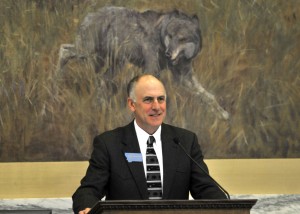Here is some information to help put into perspective what the latest revenue estimate really means. When we left the session the budget was structurally balanced but became unbalanced with the Governor’s vetoes, placing the burden of this deficit onto the next legislature.
The attached information explains why the higher than expected revenue estimate does not necessarily mean there will be a large, available, surplus. The budget passed by the 2009 legislature also became structurally  imbalanced when the recession hit and tax revenues did not meet expectations. We had one of the largest back-to-back deficits in the history of Montana. There was not “money in the bank” or “grain in the grain bin”.
imbalanced when the recession hit and tax revenues did not meet expectations. We had one of the largest back-to-back deficits in the history of Montana. There was not “money in the bank” or “grain in the grain bin”.
The Governor balanced the budget (but not structurally) by using one-time-only money, such as Otter Creek Coal revenue and PPL dollars, both of which have come into question with environmental lawsuit delays and pending court action.
The Governor’s budget of the 2011 session was again not structurally balanced because of a one-time-only strategy, which included committing all of the gas tax revenue from eastern Montana, TSEP dollars from rural infrastructure projects and firefighting money. This created a challenge for us as the proposed budget did not provide for a reasonable starting point as the Governor’s budget should. The revenue estimate is for a two year period so when we made decisions on some of the more controversial matters of the session, such as public employee pay and education spending, we had to take into consideration the inflationary and compounding effect on future budgets.
Also national and international concerns such as the national debt and the EU problems will or could affect our future tax revenue or increase states’ share of obligations as in the case of Medicaid. An argument floated in the media recently is that there is more money available than originally forecast and the Republican legislature intentionally manipulated the figures to keep spending down. Our goal was to develop a system where we spent based upon need rather than revenue expected as was traditionally done.
The revenue estimate figure was used as an upper limit, to insure we did not over spend, not as a spending target. We still have to keep in mind that this is just a projection, a best guess estimate, and the real figures won’t be known until taxes are actually collected. These are still uncertain times and having a healthy ending fund balance is good insurance. Have a good 2012 Mike


